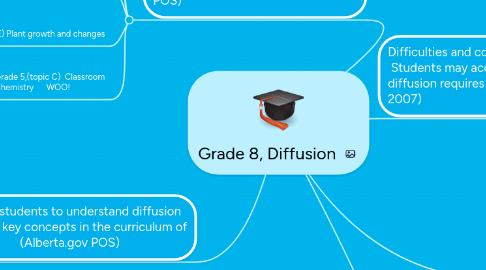
1. The foundation students need to understand diffusion (Alberta.gov POS)
1.1. Grade 1, (topic D) senses
1.1.1. focusing on smells and how the particles we are smelling move in the air. example: pollen.
1.2. Grade 1, (topic E) Needs of animals and plants
1.2.1. In reference to plants talk about roots, and how "OSMOSIS" is what makes water go into them. also with regards to animals talk about pheromones, and how they travel.
1.3. Science 14
1.3.1. Unit B: Understanding Energy Transfer Technologies
1.3.1.1. The Particle Model of Matter is explained in this unit. The differences between motion of solids, liquids, and gases. Students need to understand how particles move in order to understand why the move in diffusion and osmosis.
1.4. Grade 4,(topic E) Plant growth and changes
1.4.1. elaborate more on roots and osmosis, better depth. ask about different types of water and their effect. (salty/sweet/cold/warm)
1.5. Grade 5,(topic C) Classroom Chemistry WOO!
1.5.1. Interactions between solids and liquids. placing a sugar cube in water.. where does it go? why? can we get it back? what forces are at play?
2. Diffusion is the movement of particles from an area of high concentration to areas of lower concentration. An example of diffusion is an air freshener. An air fresher releases a strong scent. Molecules spread away from the air freshener to areas that do no have any scent molecules. The air freshener's scent can then be smelled at any spot in the room. Osmosis is almost the same as diffusion except it involves particles in a solution (usually water). A good example would be placing onion slices in different concentrations of sugar water to see what happens. Will they shrink? Grow? Stay the same?
3. It is important for students to understand diffusion because it links to key concepts in the curriculum of future grades. (Alberta.gov POS)
3.1. Grade 9
3.1.1. Unit C: Enviromental Chemistry
3.1.1.1. Diffusion is relevant to various different concepts in unit C. For starters, to understand concentration and dispersal students need to understand diffusion. This is because as explained in the definition of diffusion, particles will go from higher levels of concentration to lower levels. Thus, toxins in a lake are dispersed throughout over time. This basic understanding gives students the opportunity to understand how air and water quality can be affected.
3.2. Biology 30
3.2.1. Unit C: Cell Division, Genetics, and Molecular Biology
3.2.1.1. Different cell structures are explained in this unit. Such as hypotonic, isotonic, and hypertonic cells. A cell in a hypertonic environment shrinks because there is a higher concentration of solutes outside the cell, so the water diffuses out of the cell (through osmosis) to balance the environment outside and inside of the cell. A cell in a hypotonic environment does the opposite; it expands due to the higher level of solute concentration inside the cell causing the water to move in.
3.3. Post Secondary Education
3.3.1. Understanding how and why diffusion works will lead to an easier transition into certain University chemistry and biology courses.
